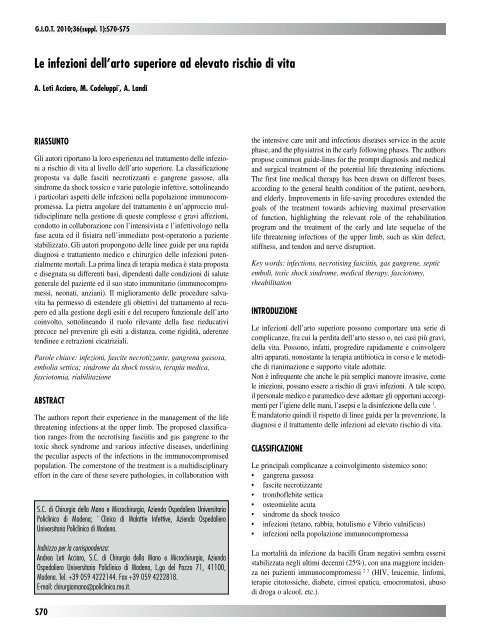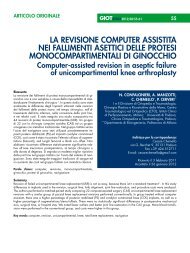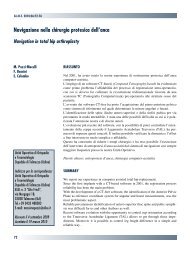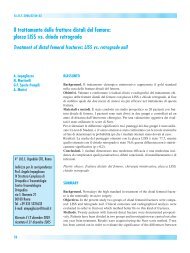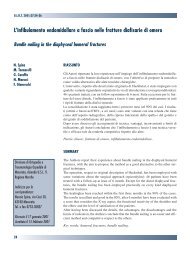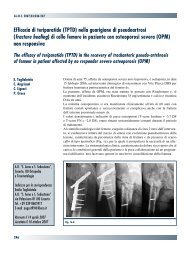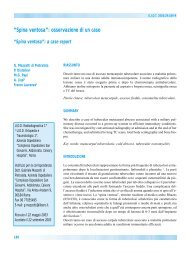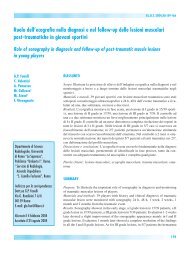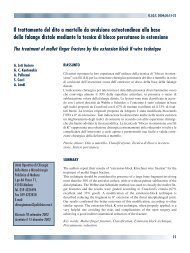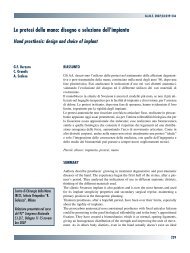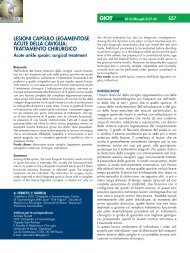30845 Suppl Giot.pdf - Giornale Italiano di Ortopedia e Traumatologia
30845 Suppl Giot.pdf - Giornale Italiano di Ortopedia e Traumatologia
30845 Suppl Giot.pdf - Giornale Italiano di Ortopedia e Traumatologia
You also want an ePaper? Increase the reach of your titles
YUMPU automatically turns print PDFs into web optimized ePapers that Google loves.
G.I.O.T. 2010;36(suppl. 1):S70-S75<br />
Le infezioni dell’arto superiore ad elevato rischio <strong>di</strong> vita<br />
a. Leti acciaro, M. Codeluppi * , a. Lan<strong>di</strong><br />
rIaSSuNTO<br />
Gli autori riportano la loro esperienza nel trattamento delle infezioni<br />
a rischio <strong>di</strong> vita al livello dell’arto superiore. La classificazione<br />
proposta va dalle fasciti necrotizzanti e gangrene gassose, alla<br />
sindrome da shock tossico e varie patologie infettive, sottolineando<br />
i particolari aspetti delle infezioni nella popolazione immunocompromessa.<br />
La pietra angolare del trattamento è un’approccio multi<strong>di</strong>sciplinare<br />
nella gestione <strong>di</strong> queste complesse e gravi affezioni,<br />
condotto in collaborazione con l’intensivista e l’infettivologo nella<br />
fase acuta ed il fisiatra nell’imme<strong>di</strong>ato post-operatorio a paziente<br />
stabilizzato. Gli autori propongono delle linee guide per una rapida<br />
<strong>di</strong>agnosi e trattamento me<strong>di</strong>co e chirurgico delle infezioni potenzialmente<br />
mortali. La prima linea <strong>di</strong> terapia me<strong>di</strong>ca è stata proposta<br />
e <strong>di</strong>segnata su <strong>di</strong>fferenti basi, <strong>di</strong>pendenti dalle con<strong>di</strong>zioni <strong>di</strong> salute<br />
generale del paziente ed il suo stato immunitario (immunocompromessi,<br />
neonati, anziani). Il miglioramento delle procedure salvavita<br />
ha permesso <strong>di</strong> estendere gli obiettivi del trattamento al recupero<br />
ed alla gestione degli esiti e del recupero funzionale dell’arto<br />
coinvolto, sottolineando il ruolo rilevante della fase rieducativi<br />
precoce nel prevenire gli esiti a <strong>di</strong>stanza, come rigi<strong>di</strong>tà, aderenze<br />
ten<strong>di</strong>nee e retrazioni cicatriziali.<br />
Parole chiave: infezioni, fascite necrotizzante, gangrena gassosa,<br />
embolia settica; sindrome da shock tossico, terapia me<strong>di</strong>ca,<br />
fasciotomia, riabilitazione<br />
aBSTraCT<br />
The authors report their experience in the management of the life<br />
threatening infections at the upper limb. The proposed classification<br />
ranges from the necrotising fasciitis and gas gangrene to the<br />
toxic shock syndrome and various infective <strong>di</strong>seases, underlining<br />
the peculiar aspects of the infections in the immunocompromised<br />
population. The cornerstone of the treatment is a multi<strong>di</strong>sciplinary<br />
effort in the care of these severe pathologies, in collaboration with<br />
S.C. <strong>di</strong> Chirurgia della Mano e Microchirurgia, Azienda Ospedaliero Universitaria<br />
Policlinico <strong>di</strong> Modena; * Clinica <strong>di</strong> Malattie Infettive, Azienda Ospedaliero<br />
Universitaria Policlinico <strong>di</strong> Modena.<br />
In<strong>di</strong>rizzo per la corrispondenza:<br />
Andrea Leti Acciaro, S.C. <strong>di</strong> Chirurgia della Mano e Microchirurgia, Azienda<br />
Ospedaliero Universitaria Policlinico <strong>di</strong> Modena, L.go del Pozzo 71, 41100,<br />
Modena. Tel. +39 059 4222144. Fax +39 059 4222818.<br />
E-mail: chirurgiamano@policlinico.mo.it.<br />
S70<br />
the intensive care unit and infectious <strong>di</strong>seases service in the acute<br />
phase, and the physiatrist in the early following phases. The authors<br />
propose common guide-lines for the prompt <strong>di</strong>agnosis and me<strong>di</strong>cal<br />
and surgical treatment of the potential life threatening infections.<br />
The first line me<strong>di</strong>cal therapy has been drawn on <strong>di</strong>fferent bases,<br />
accor<strong>di</strong>ng to the general health con<strong>di</strong>tion of the patient, newborn,<br />
and elderly. Improvements in life-saving procedures extended the<br />
goals of the treatment towards achieving maximal preservation<br />
of function, highlighting the relevant role of the rehabilitation<br />
program and the treatment of the early and late sequelae of the<br />
life threatening infections of the upper limb, such as skin defect,<br />
stiffness, and tendon and nerve <strong>di</strong>sruption.<br />
Key words: infections, necrotising fasciitis, gas gangrene, septic<br />
emboli, toxic shock sindrome, me<strong>di</strong>cal therapy, fasciotomy,<br />
rheabilitation<br />
INTrODuzIONE<br />
Le infezioni dell’arto superiore possono comportare una serie <strong>di</strong><br />
complicanze, fra cui la per<strong>di</strong>ta dell’arto stesso o, nei casi più gravi,<br />
della vita. Possono, infatti, progre<strong>di</strong>re rapidamente e coinvolgere<br />
altri apparati, nonostante la terapia antibiotica in corso e le meto<strong>di</strong>che<br />
<strong>di</strong> rianimazione e supporto vitale adottate.<br />
Non è infrequente che anche le più semplici manovre invasive, come<br />
le iniezioni, possano essere a rischio <strong>di</strong> gravi infezioni. A tale scopo,<br />
il personale me<strong>di</strong>co e parame<strong>di</strong>co deve adottare gli opportuni accorgimenti<br />
per l’igiene delle mani, l’asepsi e la <strong>di</strong>sinfezione della cute 1 .<br />
È mandatorio quin<strong>di</strong> il rispetto <strong>di</strong> linee guida per la prevenzione, la<br />
<strong>di</strong>agnosi e il trattamento delle infezioni ad elevato rischio <strong>di</strong> vita.<br />
CLaSSIFICazIONE<br />
Le principali complicanze a coinvolgimento sistemico sono:<br />
• gangrena gassosa<br />
• fascite necrotizzante<br />
• tromboflebite settica<br />
• osteomielite acuta<br />
• sindrome da shock tossico<br />
• infezioni (tetano, rabbia, botulismo e Vibrio vulnificus)<br />
• infezioni nella popolazione immunocompromessa<br />
La mortalità da infezione da bacilli Gram negativi sembra essersi<br />
stabilizzata negli ultimi decenni (25%), con una maggiore incidenza<br />
nei pazienti immunocompromessi 2 3 (HIV, leucemie, linfomi,<br />
terapie citotossiche, <strong>di</strong>abete, cirrosi epatica, emocromatosi, abuso<br />
<strong>di</strong> droga o alcool, etc.).


